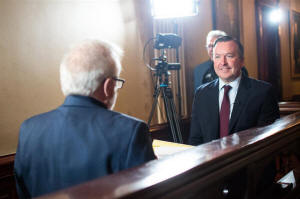With 1 week left in session, Pritzker admin says all revenue options
remain on the table
 Send a link to a friend
Send a link to a friend
[May 18, 2024]
By JERRY NOWICKI
Capitol News Illinois
jnowicki@capitolnewsillinois.com
 While the governor’s office instructed its agency directors to prepare
for $800 million in potential budget cuts last week, all facets of his
plan to raise $1.1 billion in revenue to avoid those cuts remain under
consideration. While the governor’s office instructed its agency directors to prepare
for $800 million in potential budget cuts last week, all facets of his
plan to raise $1.1 billion in revenue to avoid those cuts remain under
consideration.
Deputy Gov. Andy Manar relayed that point on the latest episode of
“Illinois Lawmakers” this week, adding that the administration is also
open to ideas from lawmakers. The program has been recently acquired by
Capitol News Illinois and filmed this week on Thursday.
“The governor has said that if the legislature doesn't support one or
multiple of those individual pieces of his proposal, whether that's
revenue or spending, that all ideas should be welcomed,” Manar told host
Jak Tichenor.
There’s a week left before the General Assembly is scheduled to adjourn
on May 24 – and two weeks left before more votes are needed to pass an
immediately effective budget – but the last-minute budgeting process is
nothing new. Budget negotiations in recent years have resulted in late
nights and the occasional overtime session but have ultimately ended in
agreement among most Democrats, who control the legislature.
“I have no doubt this will come together in the coming week or two,”
Manar said. “And we will again pass now our sixth balanced budget.”
Thus far, the negotiations between the governor's office and Democratic
leaders have spawned at least one likely addition to the revenue mix
that could raise another $30-$50 million beyond what Gov. JB Pritzker
had planned.

Sen. Cristina Castro, a high-ranking Democrat from Elgin, told Tichenor
she’s pushing a “re-renters” tax on third-party entities that resell
large blocks of hotel rooms. Castro said those groups don’t pay the
standard hotel operator’s room occupation tax, but they’d be required to
do so under her plan, which she expects to be included in the final
revenue package.
While other additions could be forthcoming, the ultimate revenue plan is
likely to include at least some portion of Pritzker’s initial proposal
if state spending is to reach the roughly $53 billion mark he proposed.
His revenue plan, and the opposition to it, is summarized below.
$526 million – extending an expiring cap
Nearly half of the governor’s proposed revenue increase comes from a
plan to make a corporate tax deduction more generous than it was for the
previous tax year.
Corporations were allowed to carry forward $100,000 in net operating
losses for the most recent tax period. Next time they file, under the
governor’s plan, they’d be able to carry forward $500,000 in net
operating losses.
So how is it revenue-generating?
The $100,000 cap was set to expire this year, meaning there would be no
cap in place if lawmakers take no action on the measure. So putting the
cap in place – and allowing corporations to claim more operating losses
– would increase revenue by $526 million.
$200 million – upping the tax on sportsbooks
Right now, Illinois sportsbooks – or those who take the bets, such as
DraftKings, FanDuel and state casinos – pay a 15 percent tax on their
net revenues. When sports betting became legal with the passage of a
2019 law, those revenues were earmarked to fund bond debt taken out to
support the state’s building infrastructure.
Pritzker has proposed hiking the tax rate to 35 percent, with everything
beyond the previous rate going to the General Revenue Fund – or the
state’s main spending account. While sportsbooks have said they’d offer
fewer profit boosts and other enticements to bettors if the measure
passes, Pritzker emphasizes it’s not those making the bets, but those
taking them that will bear the brunt of the tax hike.
$175 million – shifting some expenses to the Road Fund
Some labor unions and road builders oppose another facet of the plan –
an accounting measure that moves some public transit spending to the
Road Fund and frees up General Revenue Fund space.
[to top of second column]
|

Deputy Gov. Andy Manar talks to host Jak Tichenor on the set of
“Illinois Lawmakers,” Illinois’ longest-running state
government-focused TV program that is now a production of Capitol
News Illinois. Manar told Tichenor none of the governor’s revenue
proposals – or any brought forth by the General Assembly – are off
the table with a week remaining in the legislative session. (Capitol
News Illinois photo by Jerry Nowicki)

The Road Fund would send $175 million to the Public Transportation Fund
– an expenditure that falls in line with the 2016 “lock box” amendment
to the state’s constitution that limits taxes collected on motor fuel as
well as transportation-related fees to be used only on
transportation-related projects.
As a result of that move, an extra $175 million would remain in the
General Revenue Fund.
While at first blush it appears to be an accounting trick, such a move
faces opposition from certain labor unions – a powerful Democratic
constituency that opposes the redirection of any dollar from road- and
bridge-building.
$101 million – cap on the “retailers discount”
Another proposal would generate $101 million by capping Illinois’
so-called “retailers discount.” Illinois retailers receive a discount of
1.75 percent of the sales tax they collect as reimbursement for their
efforts to collect them. The governor’s change would cap the amount
claimed at $1,000 per month.
Illinois Department of Revenue Director David Harris said in March the
proposed cap would affect only “2 to 3 percent” of retailers – but would
have a “significant” impact on the largest retailers.
The Illinois Retail Merchants Association – a powerful lobbying group in
Springfield – opposes a reduction to the credit. During a House
committee hearing this week, IRMA President Rob Karr said Illinois
retailers do a lot of work to administer the tax – including reading
food labels to determine ingredient makeup so they know which tax to
apply on each specific item among several other bureaucratic
requirements.
All that costs time and money to administer, Karr said, noting: “1.75%
is a partial reimbursement for our costs of serving as the state sales
tax collector.”
But negotiations continue on that plan. House Bill 5844, sponsored by
Rep. WIll Guzzardi, would increase the percentage of the discount to 2.5
percent but lower the cap to $500 monthly.
$118 million – other, less publicized
proposals
The governor’s revenue plan also contains a pair of less publicized –
and likely less popular – proposals.
That includes a $25 million redistribution of real estate tax revenues
to GRF instead of the Open Space Land Acquisition and Development Fund,
which funds parks and recreation projects.
Groups like the Illinois Association of Park Districts have been
maneuvering to block the move – and prevent such “fund sweeps” moving
forward. House Bill 4502, which would prevent sweeps of OSLAD revenues,
cleared the House 108-0 and awaits action in the Senate.
The final $93 million leg of the governor’s revenue plan pertains to
individual taxpayers. It increases the state’s standard deduction – an
amount most taxpayers can claim against their taxable income – to
$2,550, up from $2,425.

In the same vein as the corporate net operating loss cap – it’s
considered revenue-generating because the deduction was slated to
increase to $2,775 under statute, due to inflation. In other words, the
governor wants the deduction to increase, but in a less generous fashion
than it would have if lawmakers simply did nothing.
Capitol News Illinois is
a nonprofit, nonpartisan news service covering state government. It is
distributed to hundreds of newspapers, radio and TV stations statewide.
It is funded primarily by the Illinois Press Foundation and the Robert
R. McCormick Foundation, along with major contributions from the
Illinois Broadcasters Foundation and Southern Illinois Editorial
Association.
 |